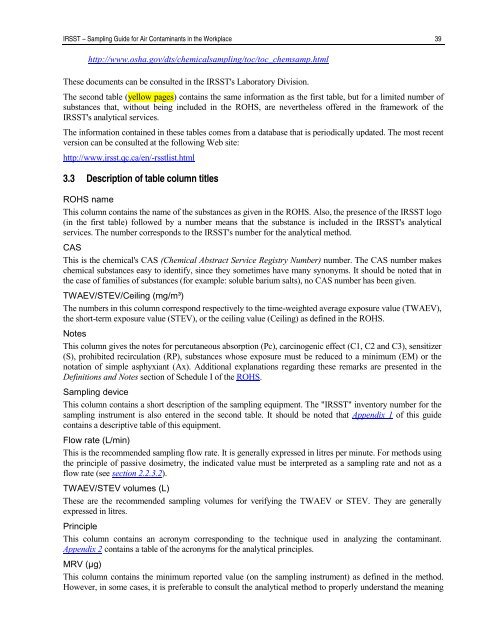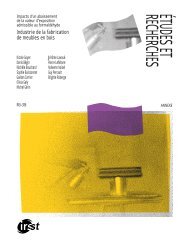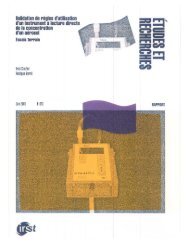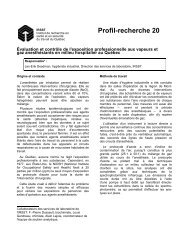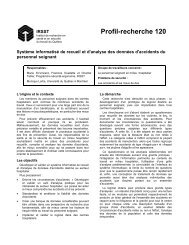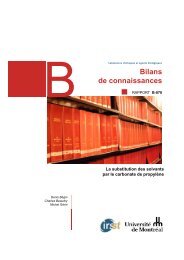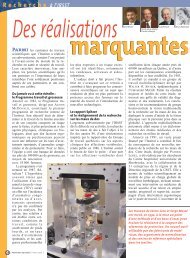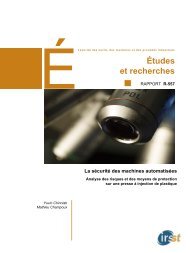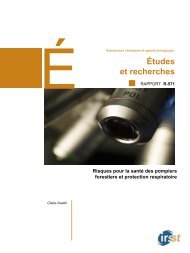Sampling Guide for Air Contaminants in the Workplace - Irsst
Sampling Guide for Air Contaminants in the Workplace - Irsst
Sampling Guide for Air Contaminants in the Workplace - Irsst
Create successful ePaper yourself
Turn your PDF publications into a flip-book with our unique Google optimized e-Paper software.
IRSST – <strong>Sampl<strong>in</strong>g</strong> <strong>Guide</strong> <strong>for</strong> <strong>Air</strong> <strong>Contam<strong>in</strong>ants</strong> <strong>in</strong> <strong>the</strong> <strong>Workplace</strong> 39<br />
http://www.osha.gov/dts/chemicalsampl<strong>in</strong>g/toc/toc_chemsamp.html<br />
These documents can be consulted <strong>in</strong> <strong>the</strong> IRSST's Laboratory Division.<br />
The second table (yellow pages) conta<strong>in</strong>s <strong>the</strong> same <strong>in</strong><strong>for</strong>mation as <strong>the</strong> first table, but <strong>for</strong> a limited number of<br />
substances that, without be<strong>in</strong>g <strong>in</strong>cluded <strong>in</strong> <strong>the</strong> ROHS, are never<strong>the</strong>less offered <strong>in</strong> <strong>the</strong> framework of <strong>the</strong><br />
IRSST's analytical services.<br />
The <strong>in</strong><strong>for</strong>mation conta<strong>in</strong>ed <strong>in</strong> <strong>the</strong>se tables comes from a database that is periodically updated. The most recent<br />
version can be consulted at <strong>the</strong> follow<strong>in</strong>g Web site:<br />
http://www.irsst.qc.ca/en/-rsstlist.html<br />
3.3 Description of table column titles<br />
ROHS name<br />
This column conta<strong>in</strong>s <strong>the</strong> name of <strong>the</strong> substances as given <strong>in</strong> <strong>the</strong> ROHS. Also, <strong>the</strong> presence of <strong>the</strong> IRSST logo<br />
(<strong>in</strong> <strong>the</strong> first table) followed by a number means that <strong>the</strong> substance is <strong>in</strong>cluded <strong>in</strong> <strong>the</strong> IRSST's analytical<br />
services. The number corresponds to <strong>the</strong> IRSST's number <strong>for</strong> <strong>the</strong> analytical method.<br />
CAS<br />
This is <strong>the</strong> chemical's CAS (Chemical Abstract Service Registry Number) number. The CAS number makes<br />
chemical substances easy to identify, s<strong>in</strong>ce <strong>the</strong>y sometimes have many synonyms. It should be noted that <strong>in</strong><br />
<strong>the</strong> case of families of substances (<strong>for</strong> example: soluble barium salts), no CAS number has been given.<br />
TWAEV/STEV/Ceil<strong>in</strong>g (mg/m³)<br />
The numbers <strong>in</strong> this column correspond respectively to <strong>the</strong> time-weighted average exposure value (TWAEV),<br />
<strong>the</strong> short-term exposure value (STEV), or <strong>the</strong> ceil<strong>in</strong>g value (Ceil<strong>in</strong>g) as def<strong>in</strong>ed <strong>in</strong> <strong>the</strong> ROHS.<br />
Notes<br />
This column gives <strong>the</strong> notes <strong>for</strong> percutaneous absorption (Pc), carc<strong>in</strong>ogenic effect (C1, C2 and C3), sensitizer<br />
(S), prohibited recirculation (RP), substances whose exposure must be reduced to a m<strong>in</strong>imum (EM) or <strong>the</strong><br />
notation of simple asphyxiant (Ax). Additional explanations regard<strong>in</strong>g <strong>the</strong>se remarks are presented <strong>in</strong> <strong>the</strong><br />
Def<strong>in</strong>itions and Notes section of Schedule I of <strong>the</strong> ROHS.<br />
<strong>Sampl<strong>in</strong>g</strong> device<br />
This column conta<strong>in</strong>s a short description of <strong>the</strong> sampl<strong>in</strong>g equipment. The "IRSST" <strong>in</strong>ventory number <strong>for</strong> <strong>the</strong><br />
sampl<strong>in</strong>g <strong>in</strong>strument is also entered <strong>in</strong> <strong>the</strong> second table. It should be noted that Appendix 1 of this guide<br />
conta<strong>in</strong>s a descriptive table of this equipment.<br />
Flow rate (L/m<strong>in</strong>)<br />
This is <strong>the</strong> recommended sampl<strong>in</strong>g flow rate. It is generally expressed <strong>in</strong> litres per m<strong>in</strong>ute. For methods us<strong>in</strong>g<br />
<strong>the</strong> pr<strong>in</strong>ciple of passive dosimetry, <strong>the</strong> <strong>in</strong>dicated value must be <strong>in</strong>terpreted as a sampl<strong>in</strong>g rate and not as a<br />
flow rate (see section 2.2.3.2).<br />
TWAEV/STEV volumes (L)<br />
These are <strong>the</strong> recommended sampl<strong>in</strong>g volumes <strong>for</strong> verify<strong>in</strong>g <strong>the</strong> TWAEV or STEV. They are generally<br />
expressed <strong>in</strong> litres.<br />
Pr<strong>in</strong>ciple<br />
This column conta<strong>in</strong>s an acronym correspond<strong>in</strong>g to <strong>the</strong> technique used <strong>in</strong> analyz<strong>in</strong>g <strong>the</strong> contam<strong>in</strong>ant.<br />
Appendix 2 conta<strong>in</strong>s a table of <strong>the</strong> acronyms <strong>for</strong> <strong>the</strong> analytical pr<strong>in</strong>ciples.<br />
MRV (µg)<br />
This column conta<strong>in</strong>s <strong>the</strong> m<strong>in</strong>imum reported value (on <strong>the</strong> sampl<strong>in</strong>g <strong>in</strong>strument) as def<strong>in</strong>ed <strong>in</strong> <strong>the</strong> method.<br />
However, <strong>in</strong> some cases, it is preferable to consult <strong>the</strong> analytical method to properly understand <strong>the</strong> mean<strong>in</strong>g


